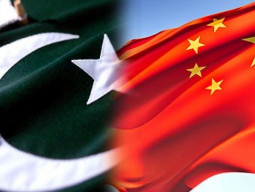
Pakistan conveyed its final position on the use of the foreign currency in its territory to the Chinese authorities during the Senior Officials Meeting (SOM) that was held on Monday in Islamabad, according to officials who were engaged in talks.
The SOM was held a day before the 7th meeting of the Joint Cooperation Committee (JCC) – the highest decision-making body of CPEC.
China offers to help Bangladesh and Myanmar defuse Rohingya crisis
There were also some issues regarding the signing of the Framework Agreement over the $2 billion Karachi Circular Railways (KCR) project.
Planning Minister Ahsan Iqbal would take up the issue (KCR) with Vice Chairman of the National Development and Reform Commission today (Tuesday) during the JCC meeting.
“If a consensus is achieved on the KCR at the political level, only then will both the sides sign the Framework Agreement,” said the officials.
“China wants to introduce its currency in Pakistan as part of its policy to internationalise the renminbi (RMB) – the official name of its currency,” according to the Pakistani officials.
The Chinese authorities wanted to avoid currency exchange risks attached with the use of the US dollar and the Pak rupee.
The Ministry of Finance and the State Bank of Pakistan opposed the Chinese demand to allow use of RMB.
However, both the sides agreed that all financial arrangements would be made under the existing bilateral Currency Swap Arrangement. The current swap arrangement is going to expire next month and both the countries decided to extend it, in addition to expanding the current swap limit which is equal to $500 million.
“China wants Pakistan to accept its currency demand and make it part of the final draft of the Long-Term Plan (2014-2030),” said the officials, adding, “Pakistan has conveyed its opposition to the demand a few months ago but the Chinese side pressed it again.”
The final position was conveyed on Monday.
“Pakistan shall promote the construction of the Gwadar Port Free Zone by drawing on the experience of China (Shanghai) Pilot Free Trade Zone and other Pilot Free Trade Zones in China, and explore RMB offshore financial business in Gwadar Free Zone,” according to the original LTP draft that Islamabad sent to Beijing for vetting in March this year.
The signing of the final draft of the LTP by China and Pakistan on Tuesday (today) is still subject to settlement of some pending issues.
Beijing also demanded that Islamabad should establish the Customs Special Supervised Areas along the CPEC route for facilitation of its investments in Special Economic Zones (SEZs), said the officials.
Pakistan accepted the demand, they added.
The LTP is the most critical element of the China-Pakistan economic relationship, as it lays the foundation of cooperation in all economic and financial areas for decades to come.
Planning Minister Ahsan Iqbal has announced to make the LTP final document public after the 7th JCC meeting.
China builds world's fastest amphibious assault vehicle
However, Pakistani authorities told The Express Tribune that the decision to make the LTP public would be taken on Tuesday by the political leadership of both the countries, as there were some sensitivities involved in it.
“Another issue that may hamper the final signing and release of the LTP document on Tuesday is the eleventh-hour demands put forth by Khyber-Pakhtunkhwa to add in the LTP,” said the officials.
The federal government would prefer to address the K-P concerns to make the LTP a consensus document, although Chinese were not agreeing to that, said the officials.
The officials said the $8.2 billion Main Line-I (ML-I) project of Pakistan Railways was also discussed in detail on Monday.
They said the Pakistani side had some issues on the high cost of the project and the amount that China will retain as the cost of capital goods and labour. They said the KCR and the ML-I project were interlinked.
The SOM also discussed Industrial Cooperation. The Pakistani side was led by Board of Investment Secretary Azher Ali Chaudhry.
The secretary said after the initial work the stage was now set for industrial cooperation to attain new heights.
In the initial phase, the Chinese side has shared its experience regarding planning and developments of SEZs. This phase will focus on the development of prioritised SEZs and to enhance understanding in other areas of Industrial Cooperation.
Both the countries also reviewed the energy sector cooperation that makes 72% of the CPEC portfolio.
Power Secretary Younus Naseem Khokar said China did not raise any major issue and the progress on the ongoing energy projects was very smooth.
He said Pakistan was in the process of adding more energy projects in order to make the full use of the 17,045 megawatts electricity generation capacity that both the countries wanted to attain under the CPEC framework.
He said prioritised energy projects would come to around 12,340MW.





























1714129906-0/Clint-Eastwood-(1)1714129906-0-270x192.webp)










COMMENTS (12)
Comments are moderated and generally will be posted if they are on-topic and not abusive.
For more information, please see our Comments FAQ